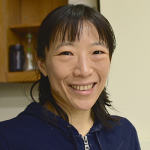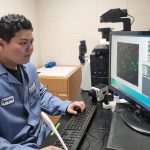Seminar with Mechanical Engineer Assistant Professor Yun Chen

“The Discovery of Viscosity Sensor that Facilitates the Counterintuitive Acceleration of Migrating Cells in Highly Viscous Fluids”
Yun Chen is an assistant professor of mechanical engineering at Johns Hopkins University. Her research is focused on developing tools to measure key parameters in mechanobiology, understanding the fundamental biophysical mechanisms that contribute to diseases, and applying knowledge gained from basic mechanobiology research to clinical applications. While a vast amount of effort has been invested in characterizing the biophysical properties in diseased cells and tissues, most of these efforts are limited to measuring the stiffness, diffusion, and viscosity of samples. Those properties are regarded as consequences of the diseases, rather than the causes. The abnormal biophysical traits can be the causes of the diseases, and her research has been dedicated to uncovering this commonly overlooked causality. Similarly, the unusual biophysical properties associated with diseases have been exploited as diagnosis tools, but few treatments, if any, employ biophysical principles to correct the errant biological processes known as pathology. Chen’s research group has been making significant progress on these uncharted territories. Their goal is to understand how altered biophysics in biological systems contribute to pathological processes in order to develop treatments for diseases. Their efforts include developing measurement tools to quantitatively characterize biophysical phenomena, such as axial stiffness of twisted DNA strands, differential force generation profiles and viscoelasticity of cancer cells compared to their normal counterparts, and identifying the underlying mechanisms for such differences, which can be exploited for disease diagnosis and treatment.
Extracellular fluid (ECF) is a critical component of the body. Cells are surrounded by and move through biological fluids that span orders of magnitudes of viscosity in vivo, including mucus, saliva, blood, and synovial fluid, among others. Interstitial fluid in the tumor microenvironment is viscous, ascites in cancer patients is highly viscous, and the mucus of patients with cystic fibrosis is highly viscous. Elevated viscosity in the tumor microenvironment and in ascites can increase the rate of cancer cell motility and promote metastasis. Elevated viscosity in mucus can inappropriately increase the migration of fibroblasts to airway wounds incurred in patients with cystic fibrosis, resulting in the worsening of fibrosis. Increases in ECF viscosity are also associated with aging and many other diseases. Despite the profound implications of ECF viscosity, our understanding of the mechanosignaling pathways that allow cells to respond to viscosity changes and the underlying mechanism leading to increased cell speeds is very limited. To gain more insights, we used bio-compatible polymers to mimic viscous ECF, aims to fill this knowledge void. We conducted detailed characterization of the cellular responses to viscosity – from the time point immediately after viscosity is increased to hours afterwards, and from single molecule force measurement to dynamic 3D cellular morphology profiling. We observed that cells immersed in highly viscous medium, which had a consistency similar to that of honey, drastically changed morphology and began moving nearly twice as fast. Step by step, we dissected the molecular cascade leading to the cell speed increase in response to elevated viscosity. Combining numerical simulation and experimental data, we showed that membrane ruffling, a common feature of adherent cells, acts in effect as a sensor of ECF viscosity, probing the hydraulic resistance of the surrounding fluid and triggering adaptive responses. In summary, we demonstrate for the first time that a universal viscosity sensing mechanism exists in adherent cells to actively probe and adapt to changes in the viscosity of the microenvironment. The physical interplay between mechanical forces that power membrane ruffling and the counteracting hydraulic resistance is at the heart of this sensing mechanism.





